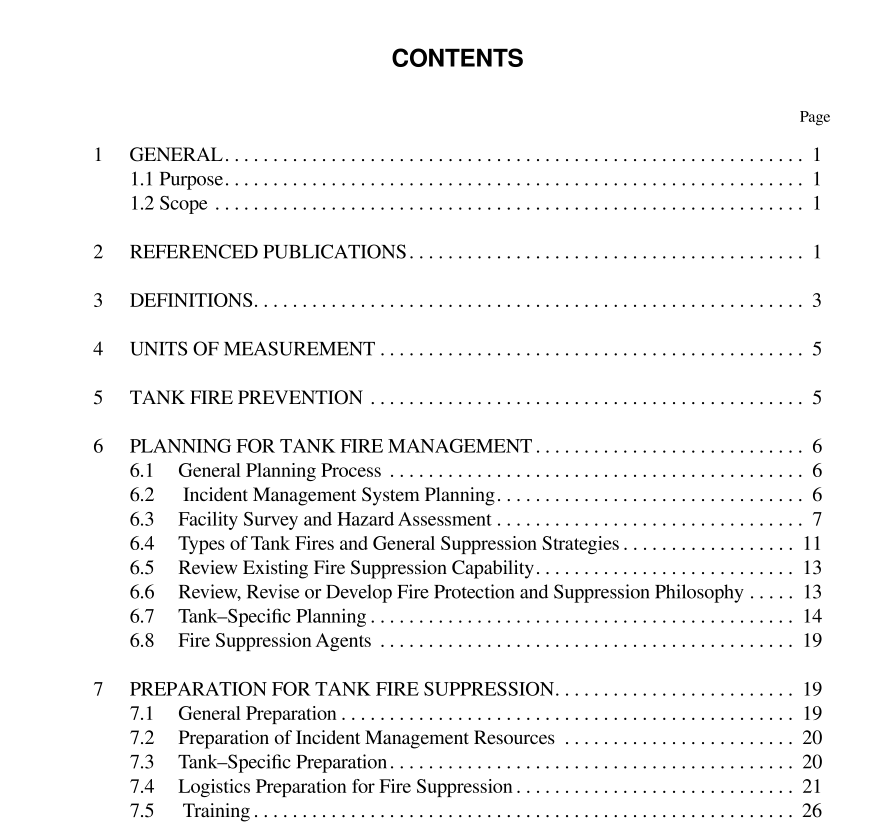API RP 2021 pdf download

API RP 2021 pdf download.Management of Atmospheric Storage Tank Fires
1 General
1.1 PURPOSE This recommended practice provides experience-based information to enhance the understanding of fires in atmo- spheric storage tanks containing flammable and combustible materials. It presents a systematic management approach which can assist tank fire prevention. If fires do occur, this information can help responders optimize fire suppression techniques to reduce the severity of an incident and reduce the potential for escalation. 1.1.1 Retroactivity Any provisions in this recommended practice related to design are intended for reference use when designing new facilities or when considering major revisions or expansions. It is not intended that the recommendations in this publication be applied retroactively to existing facilities. This publication should provide useful guidance when there is a need or desire to review programs or facilities. 1.2 SCOPE This recommended practice provides information to assist management and fire suppression personnel to manage the needs associated with safely fighting fires in above ground atmospheric storage tanks. The discussion includes planning, preparation, suppression, investigation and follow-up activi- ties as shown in Figure 1. If a liquid at a petroleum facility can burn and is stored in an unheated tank at atmospheric pressure, it fits the scope of this publication. Fires can be fueled by flammable or combus- tible liquids ranging from gasoline to lube oil, asphalt or crude oil. Some chemicals used in the petroleum industry fit this scope. Heated tanks are not addressed in this publication, but are the subject of API 2023.This publication is based on industry experience. It emphasizes planning and preparation along with practical tank fire suppression strategy and tactical guidelines. Guid- ance and precautions address developing and implementing fire suppression plans for fighting fires in and around flamma- ble and combustible liquid atmospheric storage tanks. A review of fire suppression agents is provided; emphasis is on firefighting foam, with dry chemical agents discussed for seal fires and vents. It should be understood that this document provides basic guidelines. Its application must remain flexible to relate to changing technology, philosophy and regulations. Appendix N provides “Lessons Learned” information orga- nized in the same general categories shown in Figure 1. This publication specifically excludes fighting fires in tanks containing pressurized gases (see API Publs 2510 and 2510A) and nonmetallic tanks. Detailed discussion of types of fire protection equipment and maintenance are also outside the scope of this publication. They are covered in publications such as API Publ 2001, NFPA 11, NFPA 30 and the NFPA Fire Protection Handbook ; further references are noted in Section 2. There may be situations in which it may not be possible, or appropriate, to mount an aggressive attack to extinguish a fire (as noted in 6.6). In most cases, if sufficient resources are available, extinguishing tank fires is conceptually simple. When enough of an appropriate extinguishing agent (fire- fighting foam) is properly applied to the burning fuel surface, the fire goes out. If the foam blanket is maintained until the fuel and tank metal are sufficiently cooled, the fire stays out. Accomplishing these conceptual goals involves both art and science—and provides a significant logistical challenge in addition to the fire suppression challenge. This publication provides guidance to assist understanding and systematically addressing these challenges. While this publication provides guidance for fighting tank fires, in considering tank fire issues it is prudent to review prevention of such fires. Preventing tank fires is preferable to fighting them. Section 5 and Appendix I provide brief discus- sions of fire prevention issues. Appendix O briefly reviews personal protective equipment for firefighters in the tank fire environment.









